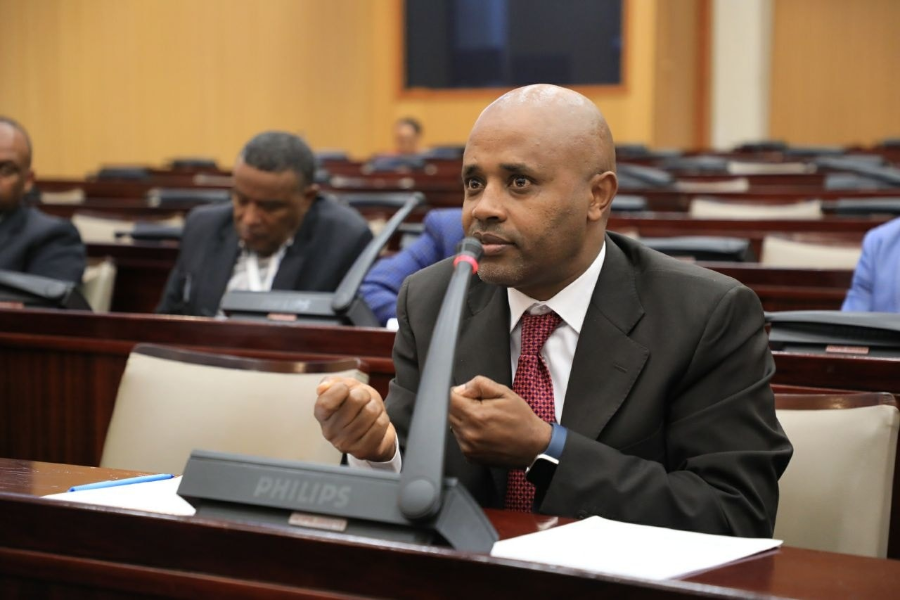
Fortune News | Jun 04,2022
Sep 19 , 2020
By Marew Abebe , Andualem Assefa
Last week, the government unveiled changes to the nation’s banknotes, including the introduction of a higher denomination note worth 200 Br. The five Birr denomination will be made into a coin, and the images and security features on the bills will also be changed.
The changes were partly made for economic reasons, including improving the liquidity at commercial banks, and to mitigate illegal activities such as money laundering and counterfeiting, according to Yinager Dessie (PhD), governor of the National Bank of Ethiopia (NBE). Indeed, the central bank has been busy taking other measures to this effect, such as limiting cash withdrawals and the amount of cash that can be held outside of banks.
On the surface at least, it seems that the governor’s explanation is valid, but it is also important to look at textbook reasons why governments change their banknotes.
The introduction of a new currency is not undertaken lightly. The motivation could be hyperinflation, exchange rate collapse, massive counterfeiting of the existing currency, or even war, according to the International Monetary Fund (IMF).
“Or it could be an intentional change—for example joining a monetary union, such as the European Monetary Union,” add financial experts at the IMF. It could also be that “the existing currency does not meet the economy’s needs. The typical economy in need of currency reform is cash-based and highly dollarised, with multiple currencies circulating at the same time.”
Such changes to banknotes, let alone the currency, are complex. Success is never guaranteed. But there are necessary preconditions that should be put in place to address distortions in the market, including sound macroeconomic policies and strong financial sector legislation. Careful preparation is necessary, such as setting up a detailed budget on the cost of printing and minting the new cash currency. The final and most challenging phase is implementation.
Has there been enough justification for putting into place a currency change in Ethiopia?
The last time there was a change to the banknotes was when the one-Birr note was changed to a coin. That was 2010, and this change was made because of the depreciating value of the Birr. A note that will thus be in a high degree of circulation will have a short lifespan, compared to the one-Birr coins, which will not be worn out for at least two decades.
On the introduction of the 200 Birr banknote and the minting of a five Birr coin, the same rationale seems to be at play, at least according to Yinager. The value of the Birr has depreciated to the degree that a higher denomination bill was required, as well as the coinage of the lowest paper-based denomination.
The reissue of the current banknotes with different features was also motivated by the desire to fight corruption.
“The new notes will curb the financing of illegal activities; corruption & contraband. Enhanced security features on the new notes will also cease counterfeit production,” tweeted Prime Minister Abiy Ahmed (PhD).
Both of these reasons were also mentioned by the Ethiopian Bankers Association. The depreciation of the Birr by an average of 0.4pc and the increased public demand for 100 Birr notes pushed the Association to propose the issuance of higher denomination banknotes. They also suggested changing the 50 Br and 100 Br banknotes. Their concern was that over 100 billion Br was circulating outside of banks, contributing to liquidity problems.
With the large quantity of Birr notes in circulation out of the banking control systems and the continued rise in prices, it is observed that the 100 Br note is left to bear the increasing demand pressure for transactions. This necessitates introducing new banknote denomination worth 200 Br.
Can banknote changes heal the economic wounds?
Ethiopia’s current microeconomic performance is unsound. Arguably, the most worrying issue is an inflation rate that averaged close to 20pc in the last fiscal year, eating away at people’s standard of living.
But even currency reform, much wider than the banknote changes just introduced, is unlikely to resolve such problems and will yield its benefits only if underpinned by fiscal and monetary action. Combined with an exchange rate unification - to eliminate the complications of both an official exchange rate and unofficial market rate – it can provide the ground for a more predictable currency market conducive to businesses and saving.
A more urgent task should be reaching the public in the implementation of the reissued banknotes. There should be campaigns to encourage people to deposit their cash currency in accounts at banks, with the added information that account holders can withdraw their money at any time in the form of new banknotes.
Another important point is timely information on the stages of the currency reform to discourage a run on banks with temporary liquidity problems. While three months does seem to be a long period for people to turn in cash they have on hand for new banknotes, there may be gaps for an economy largely fueled by paper money. Measures should be taken to prevent disruption and inconvenience, especially for those in rural communities that have not been financially included, by providing procedures where exchanges with the new banknotes could be made even after the deadline has elapsed based on specific criteria.
PUBLISHED ON
Sep 19,2020 [ VOL
21 , NO
1064]

Fortune News | Jun 04,2022

Radar | Jun 08,2019

Radar | Feb 16,2019

Viewpoints | Nov 29,2020

Radar | Dec 21,2019

Editorial | Feb 13,2021

Radar | Jul 25,2020

Exclusive Interviews | Jan 05,2020

Fortune News | Oct 12,2019

Fortune News | Jul 24,2021

My Opinion | 132041 Views | Aug 14,2021

My Opinion | 128437 Views | Aug 21,2021

My Opinion | 126364 Views | Sep 10,2021

My Opinion | 123987 Views | Aug 07,2021





Dec 22 , 2024 . By TIZITA SHEWAFERAW
Charged with transforming colossal state-owned enterprises into modern and competitiv...

Aug 18 , 2024 . By AKSAH ITALO
Although predictable Yonas Zerihun's job in the ride-hailing service is not immune to...

Jul 28 , 2024 . By TIZITA SHEWAFERAW
Unhabitual, perhaps too many, Samuel Gebreyohannes, 38, used to occasionally enjoy a couple of beers at breakfast. However, he recently swit...

Jul 13 , 2024 . By AKSAH ITALO
Investors who rely on tractors, trucks, and field vehicles for commuting, transporting commodities, and f...

Jul 12 , 2025
Political leaders and their policy advisors often promise great leaps forward, yet th...

Jul 5 , 2025
Six years ago, Ethiopia was the darling of international liberal commentators. A year...

Jun 28 , 2025
Meseret Damtie, the assertive auditor general, has never been shy about naming names...

Jun 21 , 2025
A well-worn adage says, “Budget is not destiny, but it is direction.” Examining t...

Jul 13 , 2025 . By YITBAREK GETACHEW
The Addis Abeba City Revenue Bureau has introduced a new directive set to reshape how...

Jul 13 , 2025 . By BEZAWIT HULUAGER
Addis Abeba has approved a record 350 billion Br budget for the 2025/26 fiscal year,...

Jul 13 , 2025 . By RUTH BERHANU
The Addis Abeba Revenue Bureau has scrapped a value-added tax (VAT) on unprocessed ve...

Jul 13 , 2025 . By NAHOM AYELE
Federal lawmakers have finally brought closure to a protracted and contentious tax de...